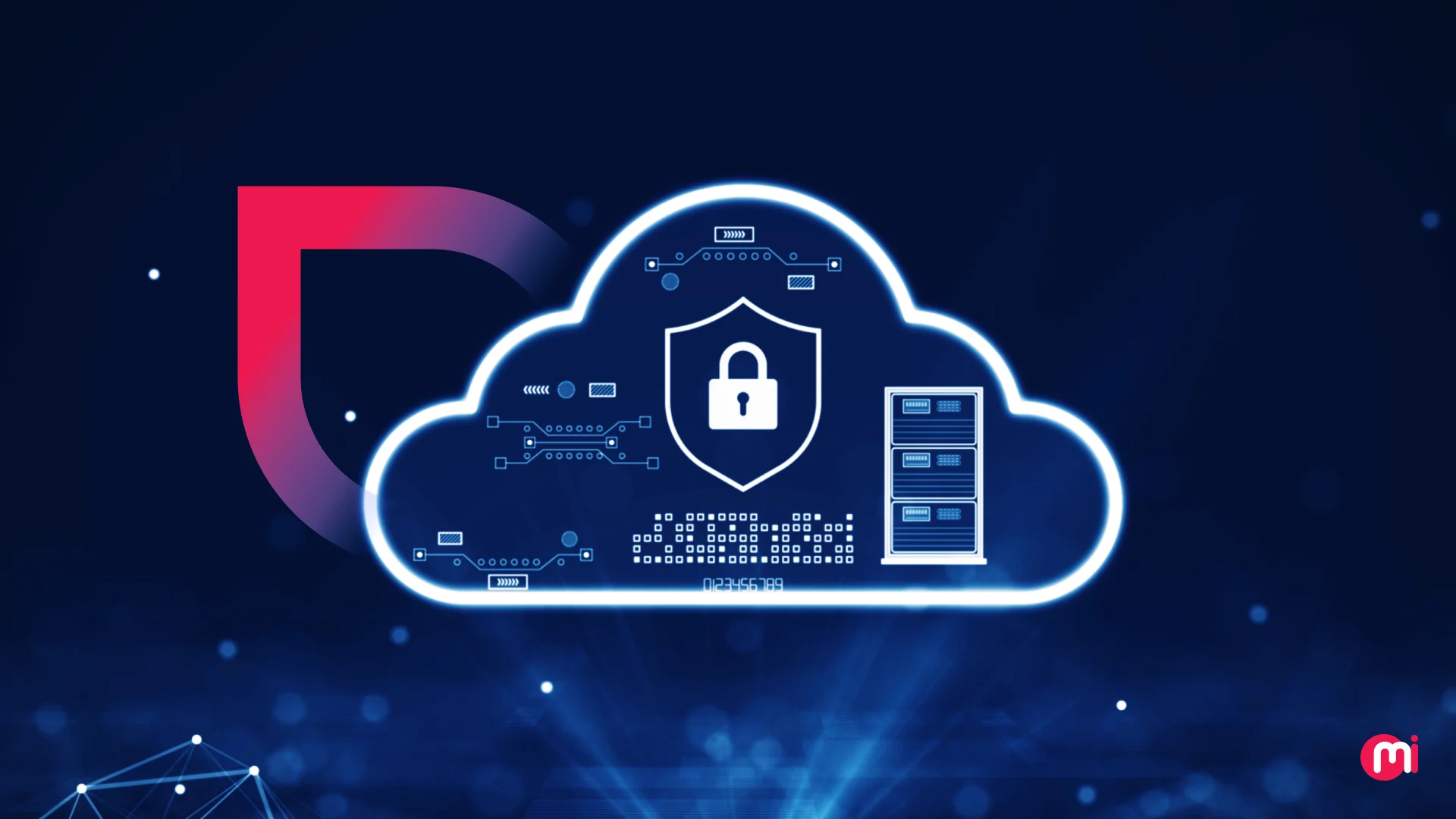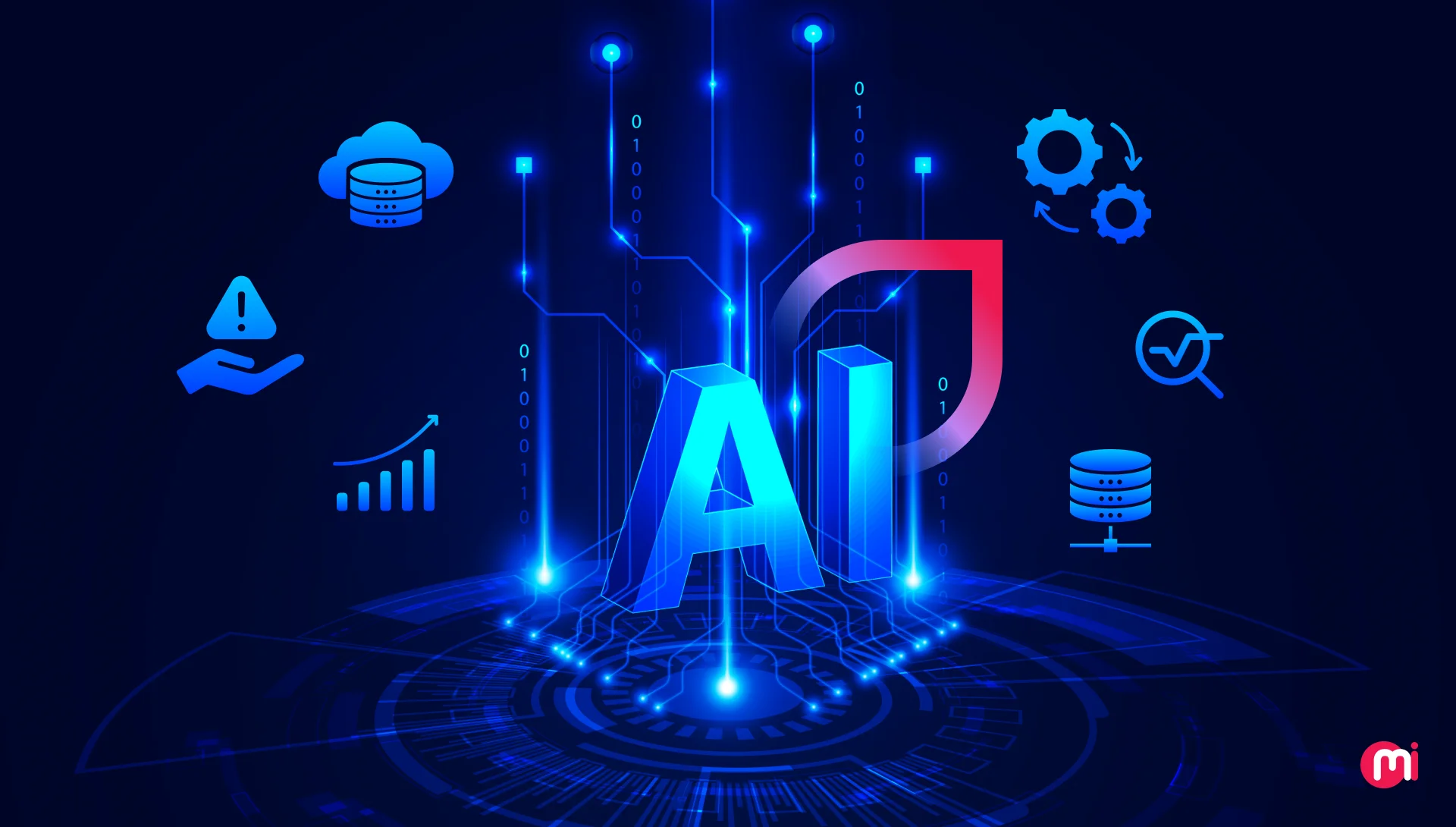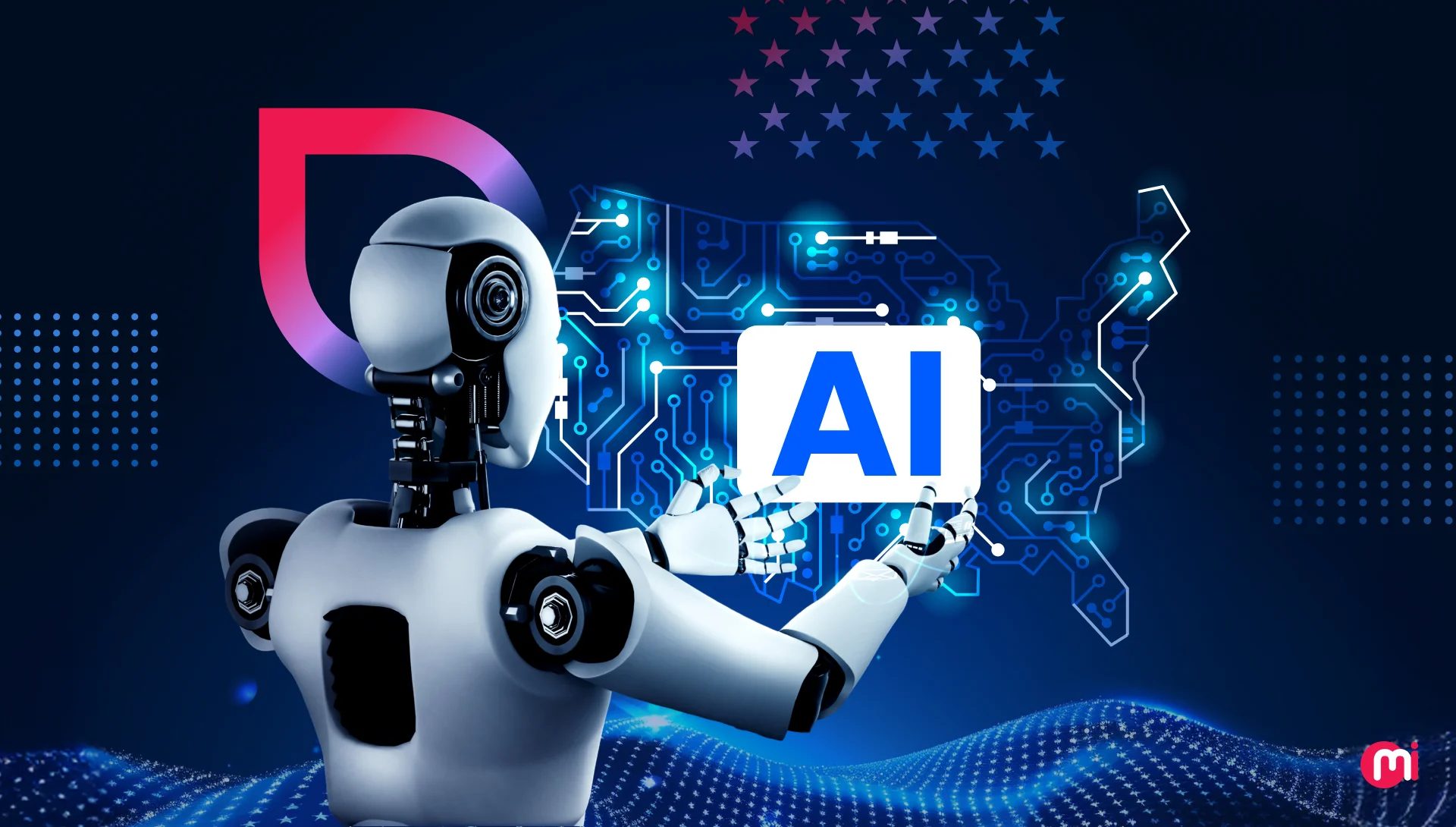AI in Cloud Security: Top 10 Ways It’s Changing the Game
- AI/ML
- July 15, 2025
With cloud computing experiencing popularity and a growing user base, new threats are also emerging at a rapid pace. Your traditional cloud security approaches may fall short in defending and safeguarding your cloud environment. That’s where AI cloud security pops up as the ultimate solution, providing automated threat identification and mitigation, security policy optimization, and more. Read this blog to learn different roles of AI in cloud security to ensure a better and safer digital workforce.
Cloud environments are growing rapidly. It is with 94% of organizations already having their workloads in the cloud and 41.4% of IT leaders planning to migrate to the cloud, as mentioned in cloud statistics. This increasing cloud adoption is also leading to growing and evolving security threats, resulting in around 80% of companies incurring hefty prices.
You can save your organization from these threats and bring speed, precision, and predictive defense to the forefront by using AI in cloud security services.
This blog covers the challenges of traditional methods and showcases 11 powerful AI roles reshaping cloud protection.

Why AI Cloud Security Is No Longer An “Option”
Traditional cloud security best practices and tools often fall short in this data-driven world full of possibilities. Specifically, when cyber attackers are getting smarter by leveraging AI-driven engineering to breach systems, even the cloud ecosystem. Plus, the cloud is no longer just a storage option but more like a digital heart for businesses.
With time, it is becoming dynamic and complex in nature, demanding more flexible and adaptable solutions. In such a scenario, it’s very obvious that traditional cloud security has reached its breaking point, struggling with the speed and scale of cloud operations and leaving the ecosystem vulnerable to sophisticated cloud threats.
There are precise reasons as well because traditional cloud security relies on:
- Manual rule configuration, which can’t keep pace with dynamic cloud environments, specifically when auto-scaling or using ephemeral containers.
- Known threat patterns, which can miss zero-day exploits, filler attacks, and AI-generated malware.
- Rules that generate thousands of low-fidelity alerts daily, leading to alert fatigue drowning SOC teams.
- Manual investigation and response, which can take hours to days.
- Manual audits, which often lack the ability to track real-time compliance across AWS/Google Cloud/Azure platforms and on-premises systems.
What are the Benefits of Using AI-Powered Cloud Security?
The emergence of AI and cloud computing synergy is a natural tech landscape evolution.
Here’s why! Cloud platforms are moving fast, are vast, and are getting data-heavy. When they deal with immense volumes of logs, telemetry, and access data in real time, it’s obvious for legacy security approaches and tools to collapse under cloud complexity.
Here’s how core AI capabilities solve modern security gaps:
- Real-Time Threat Detection at Scale: AI-powered systems can scan petabytes of data in seconds and identify signs of threats that humans or static systems would miss.
- Behavioral Intelligence: Unlike rule-based security, AI adapts to use behavior and detects deviations. This is crucial when zero-day attacks or identity-based threats are involved, which are not triggering known signatures.
- Continuous Learning & Adaptation: AI systems are continuously learning and adapting using new threat intel.
- Automation & Hyper-Speed Response: AI auto-prioritizes critical alerts and orchestrates responses.
- Predictive Risk Forecasting: AI doesn’t just flag threats but also correlates weak configurations, user risks, and threat intel to score breach likelihood.
Top 11 Roles of AI in Cloud Security
From enhancing cloud security posture management to automating threat detection and anomaly detection to cloud security policy optimization, let’s check out the top 11 AI roles in cloud security enhancement:
1. Cloud Security Posture Management (CSPM) Enhancement
CSPM is the process of continuously monitoring and assessing the security posture of cloud-based systems and infrastructure. With this, CSPM identifies and remediates misconfigurations, compliance violations, and other potential security risks within cloud environments.
Without AI:
As CSPM is a continuous process, security teams have to manually scan the cloud environment to identify misconfigurations using static rules. This manual process can be time-consuming and reactive and possibly leave room for human errors (e.g., public S3 buckets, overprivileged IAM roles).
With AI:
You can implement AI agents that can monitor and detect misconfigurations in real-time against benchmarks like CIS AWS Foundations. These agents then can detect or even automate remediation to ensure safe cloud environments.
2. Threat Detection
Cloud threat detection is the process of identifying potential and active cyber threats to the environment, helping organizations to respond swiftly to mitigate potential damage. It generally involves continuous monitoring of network traffic, analyzing security logs, and analyzing system activities in depth to identify signs of malicious activities or unauthorized access.
Without AI:
Traditional cloud security approaches and tools rely on signature-based detection, which may fail against novel attacks (also known as zero-day or polymorphic attacks, which are unique or constantly changing codes).
With AI:
When using AI for cloud security, it correlates network telemetry, endpoint behaviors, and threat intelligence using deep learning to identify Indicators of Compromise (IoCs) or Indicators of Attack (IoAs) at a greater speed and precision.
3. Anomaly Identification
The process of detecting unusual or unexpected patterns or events deviating from the ideal behavior within a cloud environment is referred to as anomaly identification. Here, anomalies can be potential problems, security breaches, or something else.
Without AI:
By not using artificial intelligence and machine learning in cloud security, specifically for anomaly identification, it can be challenging and is often stuffed with manual processes. You have to rely on rule-based systems, established monitoring techniques, and the expertise of human analysts. All of these can make anomaly identification slow, less accurate, and more prone to errors.
With AI:
Using AI in detecting anomalies in a cloud environment is like onboarding a vigilant, always-on security guard and zero-day attack radar that identifies unusual or deviating network behaviors. AI learns what “normal” looks like and flags deviations in real time. This action reduces false positives and helps to maintain a secure, performant, and cost-effective cloud environment.

4. Strengthening Access Controls
In the cloud environment, access control defines and sets up user roles, permissions, and authentication mechanisms, and resource monitoring access. This setup defines rules for who can access what cloud resources and at what level. This is usually done when you adopt and integrate cloud into your ecosystem and make changes to the access controls as it evolves.
Without AI:
Traditionally, managing access to the cloud environment is done through methods like Role-Based Access Control (RBAC), Discretionary Access Control (DAC), and Mandatory Access Control (MAC).
Without AI, managing cloud access control is like dealing with a complex and constantly shifting puzzle. You have to do everything, from configuration to monitoring to auditing, via a manual process, leading to blind spots, inefficiencies, and increased risk.
With AI:
AI makes access to the cloud environment dynamic and context-aware and also the one that adapts to user behavior and location based on the risk associated. AI also helps to leverage Just-in-Time (JIT) or Just-Enough Access (JEA) approaches based on concerning user behaviors, focusing on limiting access to systems and data.
Not just that, you can even leverage AI to implement IAM roles and Zero Trust principles, which ensure that no user or device can be trusted by default. Hence, it is highly recommended for healthcare, financial, and government bodies to leverage AI to at least secure their cloud access controls. Do check how healthcare organizations leverage Google Cloud for maximum benefits.
5. Malware Detection
Malware is malicious software designed to harm or exploit systems, networks, or devices. They can enter the cloud environment through compromised credentials, malware injections, malicious file uploads, APIs, serverless functions, or even during live cloud migration.
They can enter the cloud system in any form, including viruses, worms, trojans, spyware, adware, or even ransomware. This level of compromised cloud security can cost millions of dollars, with the average cost exceeding $4.27 million, reveals IBM.
Without AI:
A team lacking AI in cloud malware detection struggles with scalability, detection of new attacks, and processing and analyzing the vast amount of data generated in the modern cloud. This is because the team primarily relies on manual audits and signature/rule-based systems, which can’t keep up with advanced threats.
With AI:
AI cloud security uses machine learning for pattern recognition and behavioral analysis to detect anomalies and malicious behaviors to detect malware that signature-based systems might miss. AI-powered cloud security tools use advanced evasion techniques (AETs) to analyze vast data coming from various sources to detect and respond to both known and unknown threats in real time.
6. Rich Behavioral Analysis and UEBA
Behavioral analysis, specifically User and Entity Behavior Analytics (UEBA), is important in cloud environments. And it is because there are numerous users, devices, and applications accessing sensitive data stored within the cloud. This process helps to analyze user and entity behavior patterns in real time and detect anomalies and threats, which traditional cloud security measures might miss. It gives visibility over threats before they escalate.
Without AI:
Traditionally, implementing behavioral analysis and UEBA can include the use of basic security tools and techniques. The process involves collecting data from logs from various sources, network monitoring logs, analyzing data to refine normal behavior and baseline establishment, and detecting deviations that could indicate potential threats.
However, executing this process at scale can face difficulties in identifying unusual user behavior falling outside pre-set rules and making insider threats harder to catch.
With AI:
When you use AI-powered UEBA, it becomes easier to identify threats with a high degree of precision. Why? Because they are trained on vast datasets describing aggregated and anonymized user behavior, making them learn patterns. Many cloud security experts also find AI-powered UEBA efficient in detecting compromised credentials, privilege escalation, or lateral movement in real-time, which it does through login patterns, usage, and other behavior analysis.
7. Incident Response
We know that the cloud has become the core part of the majority of businesses, trusting it to store their business-sensitive information. That’s why a quick response to cloud security issues is needed. The faster the incident response is the more minimized the damage, assurance for business continuity, maintained trust during and after a security incident, better compliance with regulatory requirements, and a stronger security posture can be ensured.
Without AI:
Incident response is often slow and highly manual, with teams sifting through vast amounts of data to analyze alerts, investigate threats, and take action.
With AI:
They ensure cloud security incident response by automating threat detection and correlating threat signals, streamlining investigation, and improving prediction capabilities. Not just that, AI is also helpful in isolating infected instances and mitigating damage instantly.
8. Compliance Auditing
Cloud compliance auditing is crucial for organizations. This auditing helps identify and rectify security gaps while adhering to regulations. This process not only helps them secure their sensitive data but also prevents potential legal and financial repercussions and maintains a strong reputation in the market.
Without AI:
When doing a cloud compliance audit manually, you’d be feeling like navigating a complex maze of constantly shifting walls. During this, you have to go through extensive preparation, gather scattered evidence, and deal with the inherent complexities of cloud environments. The process at scale is not just time and resource-intensive but can also lead to potential disruptions to normal operations if not planned or executed effectively.
With AI:
When using AI for cloud compliance audits, it goes through a continuous process to audit cloud assets and configurations going against the frameworks. Once identified, it flags violations early and generates reports as needed.
9. Threat Forecasting & Risk Management
Cloud environments are prone to threats and risks like data breaches, account hijacking, data loss, and sometimes even insider threats. The cloud could face issues due to weak or misconfigured cloud platforms and integrated insecure APIs. If your cloud environment faces any sort of threat or risk, it may face regulatory compliance-related challenges. Hence, threat forecasting and risk management have significance in the cloud environment.
Without AI:
Doing threat forecasting and risk management without AI is full of manual processes, reliance on human expertise, and dealing with the sheer volume of data. Because of all these, it can feel like navigating a complex cloud maze with limited visibility and slow response times. All these can lead to delayed identification of threats, reactive patterns to deal with risks, and significant damage to finances and reputation if a security breach happens.
With AI:
AI-powered cloud security in this feels like gaining threat intelligence. It involves attack trends and environment-specific data analysis to predict potential threats and risk scores in real time. In practice, this often includes machine learning classifiers that enhance detection accuracy by identifying subtle anomalies and classifying threats faster than traditional scanning methods.

10. Encryption
Whether the cloud data is at rest or in transit, its security is a must. That’s where data encryption plays a key role in the cloud. The majority of cloud platforms require AES 256-bit encryption level for data at rest and TLS (or HTTPS) for data in transit.
You must be thinking that cloud providers like AWS, Google Cloud, and Azure by default provide AES-256 data encryption, so why is there a need for top-up encryption?
Well, this only covers basic data encryption at rest and in transit. So, top-up encryption is needed to enforce custom encryption policies, manage encryption keys securely, ensure compliance with specific regulations, and protect sensitive workflows or multi-cloud architectures beyond the default settings.
This is even more important to leverage encryption when moving to the cloud through cloud migration services.
Without AI:
It may involve configuring encryption the right way, manually managing keys securely, defining custom encryption policies, designing secure-by-default cloud environments, and more. Ensuring cloud data encryption without AI feels slow, human-dependent, and definitely not dynamic.
With AI:
AI helps organizations to automate encryption policy enforcement, detect anomalies in encrypted data usage, manage and rotate keys intelligently, and identify misconfigurations or risks in real-time. In short, AI adds a predictive and adaptive layer of cloud security, helping to prevent breaches before they happen.
11. Cloud Security Policy Optimization
Cloud is a dynamic environment where shifts in workloads, changes in user base, and the emergence of new services are constant. If not focused on optimizing cloud security rules and policies, it may leave the system outdated, overly permissive, or misaligned with evolving compliance needs.
The process of cloud security optimization looks after access controls and encryption rules and ensures that security configurations stay tight, relevant, and risk-aware.
Without AI:
It’s more like a checklist-driven process that involves periodic policy reviews, static rule-based audits, manual log analysis, spreadsheet-based access reviews, and compliance checklists. Doing cloud security policy optimization without AI is cumbersome and time-consuming, prone to human errors, lacking agility, and hard to scale.
With AI:
Doing cloud security policy optimizations with AI feels like having a 24/7 smart assistant with you. It enables continuous audits, learns, predicts, and responds in real-time with the goal of keeping the cloud posture sharp, compliant, and secure with no operational burden.
The Next Step? Crafting A Tailored AI Cloud Security Strategy With MindInventory! checklists.
Every cloud environment is different, and so is yours! Securing your cloud environment with AI requires unique configurations, risks, and compliance checklists. Hence, your AI cloud security strategy should be tailored rather than templated.
At MindInventory, we can help you implement AI cloud security in steps:
STEP 1: We first will assess your current cloud security maturity
STEP 2: Define an AI role that can match that maturity level and help you harden the security.
STEP 3: Integrate that selected AI role into your cloud ecosystem seamlessly
STEP 4: Then, we ensure cloud governance and compliance and align the cloud cost optimization strategy
STEP 5: We set up your cloud environment with frameworks, ensuring continuous improvements.
Thinking, why trust MindInventory? Here are the reasons:
- We are certified experts with proven experience across all major clouds (AWS, Google Cloud, and Azure).
- Our experts providing cloud consulting services are great communicators who explain technical concepts to even non-technical stakeholders nicely.
- Helped our customers save a minimum of $15,000/project while ensuring 99.9% uptime.
- As a cloud engineering services provider adhering to ISO 27001 and SOC 2 Type 2 standards, we ensure top-notch security for your cloud environment.
Be it cloud-native development, microservices architecture, serverless computing, or containerization, we claim our proficiency in advanced cloud practices.

FAQs About AI Cloud Security
Majorly, AI is used in cloud security to enhance threat detection, automate security tasks, and improve overall security posture.
Yes, AI is clearly visible as the crucial component of cybersecurity, specifically in the field of enhanced threat detection and response, improved vulnerability management, automated threat detection and remediation (even novel), and more.
AI has the potential to make cloud computing more efficient, scalable, and intelligent. It makes it by automating tasks, optimizing resource allocation, and enhancing cloud security, along with introducing new capabilities like advanced analytics and more.
UBA has the capabilities to analyze user behaviors across all cloud sessions and identify unusual or malicious user activities, potentially indicating security breaches, insider threats, or compromised accounts. This proactive behavior of UBA in the cloud helps the security teams respond to threats in real time and mitigate potential damage.













